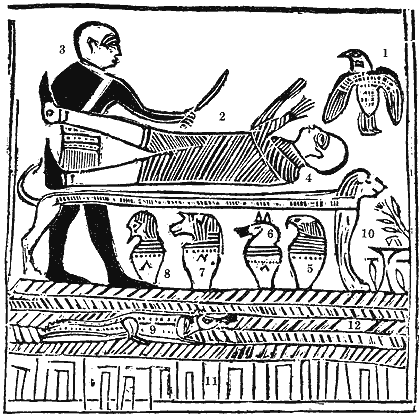
|
No. 1

|
설명
EXPLANATION
그림 1. 주의 천사.
Fig. 1. The Angel of the Lord.
그림 2. 제단 위에 묶인 아브라함.
Fig. 2. Abraham fastened upon an altar.
그림 3. 엘케나의 우상을 섬기는 제사장이 아브라함을
희생으로 바치려 함.
Fig. 3. The idolatrous priest of Elkenah attempting to
offer up Abraham as a sacrifice.
그림 4. 우상을 섬기는 제사장들이 희생을 드리는 제단.
엘케나, 립나, 마막크라, 고라스 및 바로의 신들 앞에 세워져 있다.
Fig. 4. The altar for sacrifice by the idolatrous priests,
standing before the gods of Elkenah, Libnah, Mahmackrah, Korash, and Pharaoh.
그림 5. 엘케나의 우상 신.
Fig. 5. The idolatrous god of Elkenah.
그림 6. 립나의 우상 신.
Fig. 6. The idolatrous god of Libnah.
그림 7. 마막크라의 우상 신.
Fig. 7. The idolatrous god of Mahmackrah.
그림 8. 고라스의 우상 신.
Fig. 8. The idolatrous god of Korash.
그림 9. 바로의 우상 신.
Fig. 9. The idolatrous god of Pharaoh.
그림 10. 애굽에서의 아브라함.
Fig. 10. Abraham in Egypt.
그림 11. 애굽인이 이해한 대로 하늘의 기둥을 나타내려
한 것임.
Fig. 11. Designed to represent the pillars of heaven, as
understood by the Egyptians.
그림 12. 라키양, 창공 곧 우리의 머리 위에 있는 궁창을
의미함. 그러나 이 경우에 이 주제와 관련하여 애굽인들은 히브리어의 샤마임에
해당하는 샤마, 즉 높다 또는 하늘들을 나타내려 하였음.
Fig. 12. Raukeeyang, signifying expanse, or the firmament
over our heads; but in this case, in relation to this subject, the Egyptians
meant it to signify Shaumau, to be high, or the heavens, answering to the Hebrew
word, Shaumahyeem.